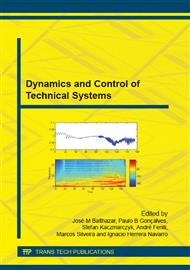[1]
S. Boccaletti, J. Kurths, G. Osipov, D.L. Valladares, and C.S. Zhou. The synchronization of chaotic systems. Phys. Reports, 366: 1, January (2002).
DOI: 10.1016/s0370-1573(02)00137-0
Google Scholar
[2]
Andreas Bruns. Fourier-, hilbert- and wavelet-based signal analysis: are they really different approaches? Journal of Neuroscience Methods, 137(2): 321 - 332, (2004).
DOI: 10.1016/j.jneumeth.2004.03.002
Google Scholar
[3]
Leon O. Chua, Makoto Itoh, Ljupco Kocarev, and Kevin Eckert. Chaos synchronization in chua's circuit. J. of Circuits, Syst. and Comp., 3(1): 93-108, (1993).
DOI: 10.1142/s0218126693000071
Google Scholar
[4]
Rosangela Follmann, Elbert E. N. Macau, and Epaminondas Rosa. Phase detection of chaos. Phys. Rev. E, 83(1): 016209, Jan (2011).
Google Scholar
[5]
Rosangela Follmann, Elbert E.N. Macau, and Epaminondas Rosa Jr. Detecting phase synchronization between coupled non-phase-coherent oscillators. Phys. Let. A, 373(25): 2146 - 2153, (2009).
DOI: 10.1016/j.physleta.2009.04.037
Google Scholar
[6]
Rosangela Follmann, Epaminondas Rosa, Elbert E. N. Macau, and José Roberto Castilho Piqueira. Identifying phase synchronous regimes in non-coherent and multiple scroll attractor systems. Int. J. Bifurcation and Chaos, 23(11): 1350179, (2013).
DOI: 10.1142/s0218127413501794
Google Scholar
[7]
Alexander E. Hramov and Alexey A. Koronovskii. Time scale synchronization of chaotic oscillators. Physica D: Non. Phenon., 206(3-4): 252 - 264, (2005).
DOI: 10.1016/j.physd.2005.05.008
Google Scholar
[8]
Christiaan Huygens. Horologium Oscillatorium. Apud F. Muguet, Parisiis, 1673.
Google Scholar
[9]
M. P. Kennedy. Robust op amp realization of chua's circuit. Frequenz, 46(3-4): 66-80, (1992).
Google Scholar
[10]
Jürgen Kurths, M. Carmen Romano, Marco Thiel, Grigory V. Osipov, Mikhail V. Ivanchenko, István Z. Kiss, and John L. Hudson. Synchronization analysis of coupled noncoherent oscillators. Nonlinear Dynamics, 44(1): 135-149, (2006).
DOI: 10.1007/s11071-006-1957-x
Google Scholar
[11]
T. Matsumoto. A chaotic attractor from chua's circuit. IEEE Transactions on Circuit and Systems, 31(12): 1055-1058, December (1984).
DOI: 10.1109/tcs.1984.1085459
Google Scholar
[12]
Choongseok Park, Robert M. Worth, and Leonid L. Rubchinsky. Fine Temporal Structure of Beta Oscillations Synchronization in Subthalamic Nucleus in Parkinson's Disease. J Neurophysiol, 103(5): 2707-2716, (2010).
DOI: 10.1152/jn.00724.2009
Google Scholar
[13]
Luis M. Pecora and Thomas L. Carroll. Synchronization in chaotic systems. Phys. Rev. Lett., 64(8): 821, February (1990).
Google Scholar
[14]
T. Pereira, M. S. Baptista, and J. Kurths. General framework for phase synchronization through localized sets. Phys. Rev. E, 75(2): 026216, Feb (2007).
DOI: 10.1103/physreve.75.026216
Google Scholar
[15]
A. S. Pikovsky, M. G. Rosenblum, G. V. Osipov, and J. Kurths. Phase synchronization of chaotic oscillators by external driving. Physica D, 104: 219, (1997).
DOI: 10.1016/s0167-2789(96)00301-6
Google Scholar
[16]
M. C. Romano, M. Thiel, J. Kurths, I. Z. Kiss, and J. L. Hudson. Detection of synchronization for non-phase-coherent and non-stationary data. Europhys. Lett., 71: 237-329, (2005).
DOI: 10.1209/epl/i2005-10095-1
Google Scholar
[17]
E. Rosa Jr., E. Ott, and M. H. Hess. Transition to phase synchronization of chaos. Phys. Rev. Lett, 80(8): 1642, Feb (1998).
DOI: 10.1103/physrevlett.80.1642
Google Scholar
[18]
M. G. Rosenblum, A. S. Pikovsky, and J. Kurths. Phase synchronization of chaotic oscillatiors. Phys. Rev. Lett., 76(11): 1804, March (1996).
DOI: 10.1103/physrevlett.76.1804
Google Scholar
[19]
O E Rössler. An equation for continuous chaos. Phys. Lett. A, 57(5): 397, (1976).
Google Scholar
[20]
Carten Schäfer, M. G. Rosenblum, A. S. Pikovsky, and J�rgen Kurths. Heartbeat synchronized with ventilation. Nature, 392: 239, (1998).
DOI: 10.1038/32567
Google Scholar
[21]
C.J. Stam, T. Montez, B.F. Jones, S.A.R.B. Rombouts, Y. van der Made, Y.A.L. Pijnenburg, and Ph. Scheltens. Disturbed fluctuations of resting state eeg synchronization in alzheimer's disease. Clinical Neurophysiology, 116(3): 708- 715, (2005).
DOI: 10.1016/j.clinph.2004.09.022
Google Scholar
[22]
E. F. Stone. Frequency entrainment of phase coherent attractor. Phys. Lett. A, 163(5-6): 367- 374, (1992).
Google Scholar
[23]
Steven H. Strogatz and Ian Stewart. Coupled oscillators and biological synchronization. Scientific American, 269(6): 68, december (1993).
Google Scholar
[24]
Ming-Chya Wu and Chin-Kun Hu. Empirical mode decomposition and synchrogram approach to cardiorespiratory synchronization. Phys. Rev. E, 73: 051917, May (2006).
DOI: 10.1103/physreve.73.051917
Google Scholar
[25]
Tolga Yalcinkaya and Ying-Cheng Lai. Phase characterization of chaos. Phys. Rev. Lett., 79(20): 3885-3888, Nov (1997).
Google Scholar
[26]
Tomoji Yamada and Hirokazu Fujisaka. Stability theory of synchronized motion in coupledoscillator systems. Prog. of Theor. Phys., 72(5): 885, (1984).
Google Scholar


